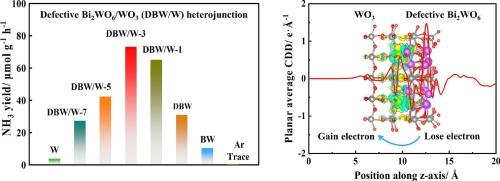In situ growth of defect-adjustable Bi2WO6/WO3 heterojunction for efficient photocatalytic N2 reduction
IF 4.3
2区 工程技术
Q2 ENGINEERING, CHEMICAL
引用次数: 0
Abstract
Herein, a strategy for the construction of defect-adjustable heterojunction photocatalysts with well-matched energy levels and tight binding is proposed. And defect-adjustable Bi2WO6/WO3 heterojunction is prepared in situ by solvothermal method to improve the N2 reduction performance. The results show that compared with the defect-free Bi2WO6/WO3 heterojunction grown in water, the defective Bi2WO6 ultra-small nanosheets grown in glycol are tightly bound to WO3 nanorods, increasing the contact area between the two and promoting the separation of photogenerated carriers. EPR results show that glycol has reducibility and effectively construct oxygen vacancy, which facilitates N2 adsorption and activation. Meanwhile, the results show that S-scheme defective Bi2WO6/WO3 heterostructure is formed, which results in higher NH3 yield. The NH3 yield of optimized Bi2WO6/WO3 heterojunction is 73.4μmol g−1h−1, which is significantly higher than that of pure Bi2WO6 and WO3. This work provides a new idea for the design of tightly bonded heterojunction photocatalyst.

原位生长缺陷可调Bi2WO6/WO3异质结用于高效光催化N2还原
在此,提出了一种构建具有良好匹配能级和紧密结合的缺陷可调异质结光催化剂的策略。采用溶剂热法原位制备了缺陷可调Bi2WO6/WO3异质结,提高了氮还原性能。结果表明:与在水中生长的无缺陷Bi2WO6/WO3异质结相比,在乙二醇中生长的缺陷Bi2WO6超小纳米片与WO3纳米棒紧密结合,增加了两者之间的接触面积,促进了光生载流子的分离;EPR结果表明,乙二醇具有还原性,能有效构建氧空位,有利于N2吸附和活化。同时,形成了S-scheme缺陷Bi2WO6/WO3异质结构,提高了NH3产率。优化后的Bi2WO6/WO3异质结NH3产率为73.4μmol g−1h−1,显著高于纯Bi2WO6和WO3。本研究为紧密结合异质结光催化剂的设计提供了新的思路。
本文章由计算机程序翻译,如有差异,请以英文原文为准。
求助全文
约1分钟内获得全文
求助全文
来源期刊

Chemical Engineering Science
工程技术-工程:化工
CiteScore
7.50
自引率
8.50%
发文量
1025
审稿时长
50 days
期刊介绍:
Chemical engineering enables the transformation of natural resources and energy into useful products for society. It draws on and applies natural sciences, mathematics and economics, and has developed fundamental engineering science that underpins the discipline.
Chemical Engineering Science (CES) has been publishing papers on the fundamentals of chemical engineering since 1951. CES is the platform where the most significant advances in the discipline have ever since been published. Chemical Engineering Science has accompanied and sustained chemical engineering through its development into the vibrant and broad scientific discipline it is today.
 求助内容:
求助内容: 应助结果提醒方式:
应助结果提醒方式:


